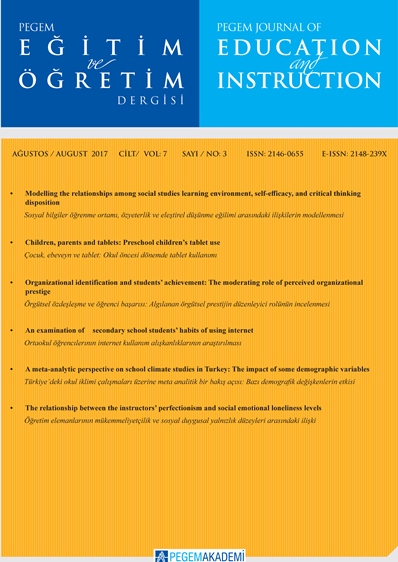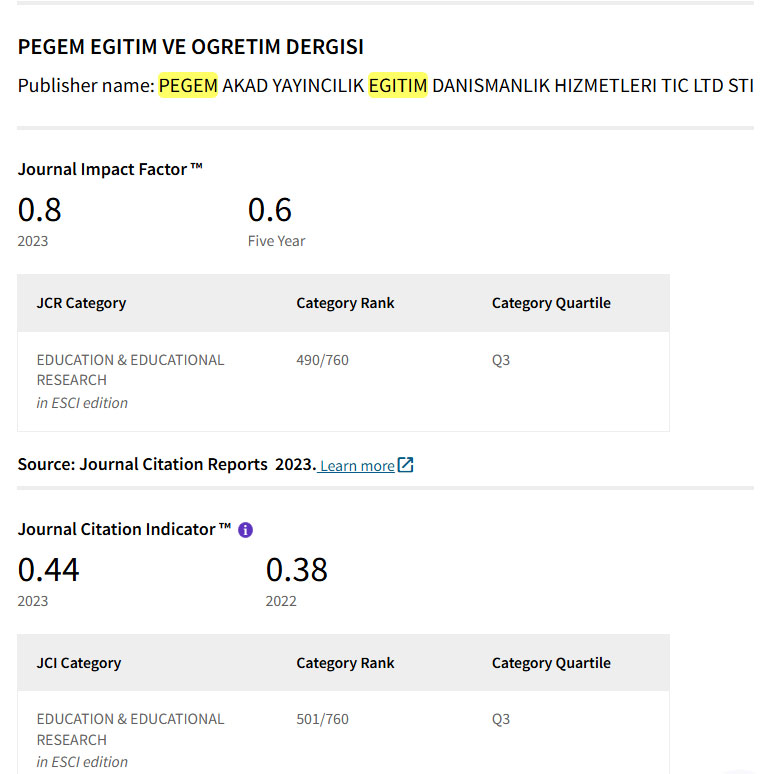Foreign language anxiety of gifted students in Turkey
DOI:
https://doi.org/10.47750/pegegog.11.04.16Keywords:
Foreign language, anxiety and gifted students.Abstract
Anxiety related to foreign language has been widely held in recent years and associated studies have found a negative correlation between language anxiety and the academic performance of English speaking students. Whenever foreign language learners express themselves in a second language, there is an anxiety about the image that is communicated through linguistic difficulties. There is a fear that his personal image will be distorted because of grammatical errors and rarefied vocabulary. This study aims to research foreign language anxiety among gifted students who are attending science, math and art classes in Science and Art Centers (BİLSEM). For this purpose, 146 (81 males and 65 female) gifted and talented students aged 12-17 were selected. This study used a mixed (quantitative method and qualitative) thereby applying a Foreign Language Anxiety Scale (for English language) to participants and using semi-structured interview questions with 10 gifted students (5 sciences, 2 arts and 3 from music class). The quantitative data results were compared via SPSS and the qualitative date were analyzed The study revealed that participants attending art and music classes have far lower foreign language anxiety levels than those attending science classes. This difference between group was statistically meaningful according to SPSS analysis. The qualitative also study supported the results by quantitative studies.
Downloads
References
Alrabai, F. (2014). A Model of Foreign Language Anxiety in the Saudi EFL Context. English language teaching, 7(7), 82-101
Alencar, E. M. L. S. (2001). Creativity and education of gifted. Petrópolis, RJ: Vosez
Argyle, E., Bolton, G. (2005). Art in the community for potentially vulnerable mental health groups. J. Health Education, 105(5), 340–354.
Asaridou, S. S. and McQueen, J. M. (2013). Speech and music shape the listening brain: Evidence for shared domain-general mechanisms. Frontiers in Psychology 4DOI: https://doi.org/10.3389/fpsyg.2013.00321
Bar-On, R. (2007). The impact of emotional intelligence on giftedness. Gifted Education lnternational, 23, 122-137
Baş, G . (2013). Yabanci Dil Öğrenme Kaygisi Ölçeği: Geçerlik Ve Güvenirlik Çalişması . Türkiye Sosyal Araştırmalar Dergisi , 172 (172) , 49-68 . Retrieved from https://dergipark.org.tr/tr/pub/tsadergisi/issue/21496/230465
Besson, M., and Faïta, F. (1995). An event-related potential (ERP) study of musical expectancy: comparison of musicians with non-musicians. Psychol. Hum. Percept. Perform. 21, 1278–129
Brown, H. D. (2007) Teaching by principles: an interactive approach to language pedagogy. Longman: San Francisco.
Brown, H. D. (2007). Principles of language learning and teaching (5th ed.).White Plains, New York: Pearson Education, Inc
Büyüköztürk, Ş., Kılıç Çakmak, E., Akgün, Ö.E., Karadeniz, Ş. ve Demirel, F. (2008). Bilimsel araştırma yöntemleri (14. Baskı). Ankara: Pegem Yayınları
Chobert, J., & Besson, M. (2013). Musical expertise and second language learning. Brain Sciences, 3(2), 923–940. https://doi.org/10.3390/brainsci3020923
Christopher, M, M., & Shewmaker, J. (2010). How does perfectionism relate to gifted and high-ability learners? Gifted Child Today, 33. 21-30.
Creech, A., Hallam, S., Varvarigou, M., & McQueen, H. (2014). Active ageing with music. London, UK: Institute of Education Press.
Demir, V. & Demir, A. (2018). Sanatla Terapi Programı ve Etkileşim Grubu Uygulamasının Ruhsal Belirti Düzeyleri Üzerindeki Etkisi. 3. Psikiyatri Zirvesi & 10. Ulusal Anksiyete Kongresi’nde sunulan bildiri.
Demir, V., & Yıldırım, B. (2017). Sanatla Terapi Programının Üniversite Sınavına Hazırlanan Öğrencilerin Depresyon, Anksiyete ve Stres Belirti Düzeylerine Etkililiği. Ege Eğitim Dergisi, 18(1), 311-344.
Feldhusen, J. F., Denny, T., & Condon, C. F. (1965). Anxiety, divergent thinking, and achievement. Journal of Educational Psychology, 56(1), 40-45. http://dx.doi.org/10.1037/h0021952
Fleischer, G., & Cohen, I. S. (1965). The relationship between test anxiety and tests of creativity. Proceedings of the Annual Convention of the American Psychological Association, 311-312.
François, C. and Schön, D. (2011). Musical expertise boosts implicit learning of both musical and linguistic structures. Cerebral Cortex 21(10): 2357–2365, DOI: https://doi.org/10.1093/cercor/bhr022
François C., Cunillera T., Garcia E., Laine M., Rodriguez-Fornells A. (2017). Neurophysiological evidence for the interplay of speech segmentation andword-referentmapping during novelword learning. Neuropsychologia 98, 56–67. 10.1016
Harrison, G. E., & Van Haneghan, J. P. (2011). The gifted and the shadow of the night: Dabrowski's overexcitabilities and their correlation to insomnia, death anxiety, and fear of the unknown. Journal for the Education of the Gifted, 34, 669-697.
Gagné, F. (2012). A proposal for subcategories within the gifted or talented populations. Gifted Child Quarterly, 42, 87–95
Gallagher, J. J. (2003). Issues and challenges in the education of gifted students. In N. Colangelo & G. A. Davis (Eds.), Handbook of gifted education (3rd ed.) (pp. 11-23). Boston: Pearson Education.
Grimm, V. E., & Nachmias, C. (1977). The effect of cognitive style and manifest anxiety on intellectual and vocational interest in adolescents. Journal of Vocational Behavior, 10(2), 146-15
Horwitz, E. K. (2001) Language anxiety and achievement. Annual Review of Applied Linguistics, USA: Cambridge University Press, n. 21.
Horwitz, E. K., Horwitz, M. B., & Cope, J. (1986). Foreign language classroom anxiety. The Modern language journal, 70(2), 125-132.
Horwitz, E. K. (1986) Preliminary evidence for the reliability and validity of a foreign language anxiety scale. TESOL Quarterly, v. 20, n. 3.
Kane, M. (2016). Gifted Learning Communities: Effective Teachers at Work. In F. H. R. Piske, T. Stoltz, J. M. Machado, & S. Bahia (Orgs.), Altas habilidades/Superdotacao (AH/SD) e Criatividade: Identificacao e Atendimento [Giftedness and Creativity: Identification and Specialized Service] (pp. 77-94). Curitiba: Jurua
Kaplan. L, (1990). Helping gifted students with stress management. The Eric Clearinghouse on Disabilities and Gifted Education. Retrieved from www.eric.ed,goy/ERICWebPortal/recordDetail?accno=ED32l493
Kirk. S. A., & Gallagher, J. J. (1989). Educating exceptional children (6th Ed.). Boston: Houghton Mifflin
Kim, J-H. (2000). Foreign language listening anxiety: A study of Korean students learning English. Unpublished doctoral dissertation, The University of Texas, Austin
Kruk, M. (2018). Changes in foreign language anxiety: A classroom perspective. International Journal of Applied Linguistics, 28(1), 31-57
Kunt, K & Tortop, H. S. (2013). Türkiye’deki üstün yetenekli öğrencilerin bilim ve sanat merkezlerine ilişkin metaforik algıları. Üstün Yetenekliler Eğitimi Araştırmaları Dergisi 1(2), BİLSEM Özel Sayısı, 117-127
Lazarus, R.S. (1999). Stress and emotion: A new synthesis. London: Free Association Books. 340 pp
Lind, S. (2001). Overexcitability and the gifted. Supporting Emotional Needs of the Gifted. Available from www.sengifted.org
Lusebrink, V.B. (2004). Art therapy and the brain: An attempt to understand the underlying processes of art expression in therapy. J. Amer. Ther. Assoc., 21(3), 125–135.
MacIntyre, P. D., & Gardner, R. C. (1991). Methods and results in the study of anxiety and language learning: A review of the literature. Language learning, 41(1), 85-117
MacIntyre, P. D. (1999). Language anxiety: A review of the research for language teachers. Affect in foreign language and second language learning: A practical guide to creating a lowanxiety classroom atmosphere, 24, 41
Milli Eğitim Bakanlığı (MEB), (2007). Bilim ve Sanat Merkezi Yönergesi. http://mevzuat.meb.gov.tr/html/2530_1.html
Osborne, B. (2015). How Art Helps Us To Relax. http://www.creativegreen.co.uk/
Petrillo, de L., Winner E. (2005). Does Art Improve Mood? A Test of a Key Assumption Underlying Art Therapy. J. Amer. Art Ther. Assoc., 22(4), 205–212.
Piske, F. H. R., Stoltz, T., & Machado, J. (2014). Creative Educational Practices for Inclusion of Gifted Children. Creative Education, 5, 803-808.
Richard-Amato, P. A. (2003). Making it happen: From interactive to participatory language teaching : theory and practice. White Plains, NY: Longman
Oxford, R. L. (1999). Anxiety and the language learner: New insights. Affect in language learning, 58-67
Sander, Pl & Stella W. (2010). Our teachers and what we have learnt from them. Psychology Teaching Review Vol. 16 No. 1. Pp.61-69.
Slevc, L. R. (2012). Language and music: Sound, structure, and meaning. WIREs Cognitive Science 3(4): 483–492, DOI: https://doi.org/10.1002/wcs.1186
Strauss, H., Hadar, M., Shavit, H., & Itskowitz, R. (1981). RELATIONSHIP BETWEEN CREATIVITY, REPRESSION, AND ANXIETY IN FIRST GRADERS. Perceptual and Motor Skills, 53(1), 275-282. http://dx.doi.org/10.2466/pms.1981.53.1.275
Spanondis, L.C. (2003). Art Therapy and the Effects of a Stress Management Program. Tallahassee: Florida State University. 156 pp
Tippey, J. G., & Burnham, J. J. (2009). Examining the fears of gifted children. Journai for the Education of the Gifted, 32, 321-339,
Ünver, G., Bümen, N. T., Başbay, M. (2010). Ortaöğretim alan öğretmenliği tezsiz yüksek lisans derslerine öğretim elemanı bakışı: Ege Üniversitesi Örneği. Eğitim ve Bilim. 35 (155),63-77.
Yeganehpour, P; Takkaç, M.(2016) Using ice-breakers in improving every factor which considered in testing learners speaking ability. International Journal on New Trends in Education and Their Implications, p. 15-32, n.1 v.7.
Yoon, T. (2012). Teaching English though English: Exploring Anxiety in Non-native Pre-service ESL Teachers. Theory & Practice in Language Studies, 2(6).
Walsh, S.M., Chang, C.Y., Schmidt, L.A., Yoepp, J.H. (2005). Lowering stress while teaching research: A creative arts intervention in the classroom. J. Nurs. Edu., 44(7), 330–333.
White, K. (1968). Anxiety, Extraversion-Introversion, and Divergent Thinking Ability. The Journal of Creative Behavior, 2(2), 119-127. http://dx.doi.org/10.1002/j.2162-6057.1968.tb00093.x
Winner, E. (1996). Gifted children: Myths and realities. New York, NY: Basic Book
Downloads
Published
How to Cite
Issue
Section
License
Copyright (c) 2021 Pegem Journal of Education and Instruction

This work is licensed under a Creative Commons Attribution-NonCommercial 4.0 International License.
Attribution — You must give appropriate credit, provide a link to the license, and indicate if changes were made. You may do so in any reasonable manner, but not in any way that suggests the licensor endorses you or your use.
NonCommercial — You may not use the material for commercial purposes.
No additional restrictions — You may not apply legal terms or technological measures that legally restrict others from doing anything the license permits.




